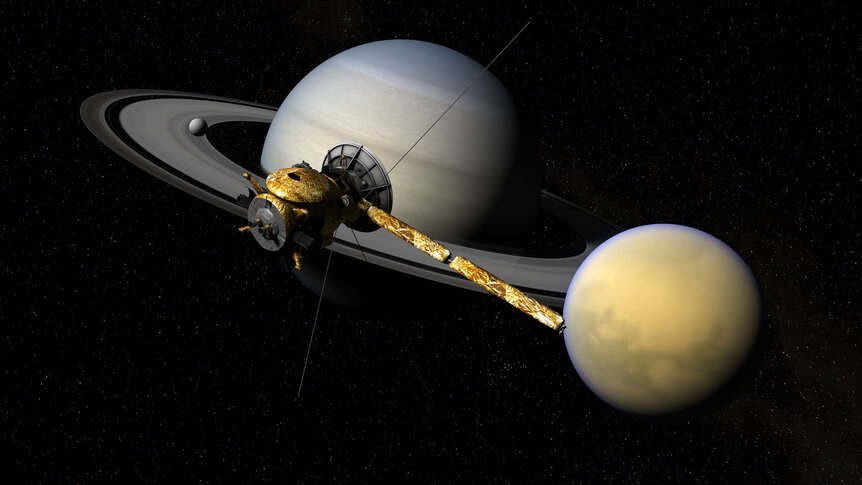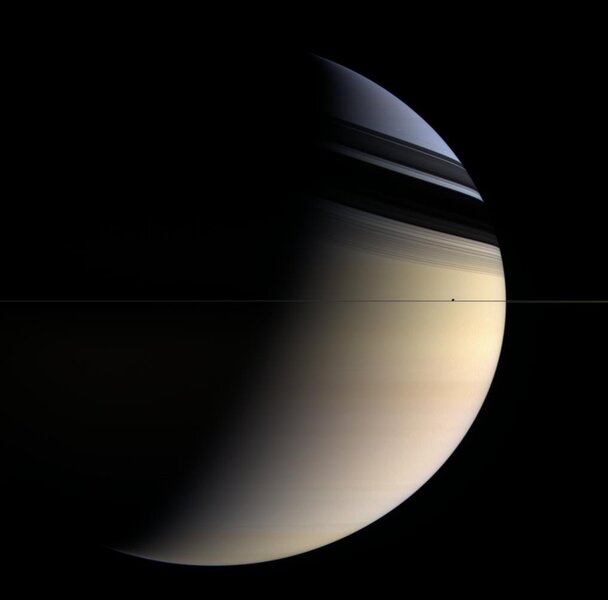Create a free profile to get unlimited access to exclusive videos, sweepstakes, and more!
Could the destruction of a large icy moon explain both Saturn’s tilt and its rings?
Saturn's rings may be the debris from a long-dead moon.

Saturn’s rings are arguably the most gorgeous and spectacular structures in the solar system. They’re so flat — proportionally thinner than a single sheet of paper — that when they’re edge-on we can’t see them at all; if it weren’t for the fact that Saturn is tilted so we see them at an angle they’d be nearly invisible.
A new paper just published posits that those two things are actually linked. A team of astronomers thinks that it’s possible that the reason Saturn’s rings exist and the planet itself is tilted may be due to the same phenomenon: The breakup of a large icy moon about a hundred million years ago [link to paper].
Saturn’s rotation axis — it’s north/south pole axis — is tipped with respect to its orbit by about 27°. That’s similar to Earth’s own tilt, properly called the obliquity, of about 23°. But that’s odd, because big gas giant planets should have an obliquity very close to 0. They formed out of the same disk of gas and dust and ice that all the planets coalesced out of; Earth suffered a massive impact that tilted it. But gas giants are so huge that a single impact, unless it’s soul-freezingly big, wouldn’t affect their tilt much. Jupiter, for example, has an obliquity of just 3°* .
Saturn’s large obliquity means something else must have tipped it over. But it doesn’t have to have been a massive one-time-only event. It could’ve been something much more subtle acting over millions or even billions of years.
A key point is that Saturn’s spin axis undergoes precession, wobbling around in a circle, changing its orientation on the sky like the motion of a dying top. Earth’s axis does this every 26,000 years, due to torque from the Moon. But in Saturn’s case astronomers also noticed that the time it takes Saturn’s spin axis to precess once is very close to the time it takes Neptune’s orbital axis to precess once as well, roughly 2 million years. Could the two be connected?
It’s possible, and a lot of work has gone into seeing how they’re connected. This gets more complicated because Saturn’s tilt will be affected by its satellites, especially Titan, the second largest moon in the solar system and larger than the planet Mercury. Almost all of Saturn’s big moons orbit directly over its equator. A slight tilt in Saturn’s axis could then be amplified by the moons; the Sun would yank on the tilted moon orbits, which in turn yank on Saturn, causing its tilt to grow. Due to a complicated exchange of energy, this would also affect the orbit of Titan, moving it farther out from Saturn.
The thing is, Titan would have to move away from Saturn very slowly to accomplish this, but it’s moving outward much faster than models predict. In the new work, the astronomers show that Saturn itself spins in such a way that just the influence of Neptune and the Sun on the planet can’t have tilted it over by 27° as long as Titan is moving out that rapidly. And by rapidly, they mean its orbit increases by about 14 centimeters per years, roughly three times faster than your fingernails grow.
If that’s the case, then why is Saturn tilted so far over?
They posit it used to have another moon, one made almost entirely of water ice that was about the same size as Saturn’s moon Iapetus, roughly 1,500 kilometers in diameter, and circled Saturn between the orbits of Titan and Iapetus. They nicknamed this theoretical moon Chrysalis.
So where is this moon now? Destroyed… but not gone. Not entirely.
Like Titan it too would have slowly moved away from Saturn over time, but at some point it would’ve moved into a resonance with Titan, meaning the time it took to orbit Saturn once was a simple multiple of Titan’s period. When this happened the influence of Titan on Chrysalis grew huge. It destabilized Chrysalis’s orbit. Using computer models to simulate the hypothesized moon’s orbit, they found that Titan could eject the moon out of the system entirely, but in many test runs it actually flung the moon close to Saturn.
So close, in fact, that the immense gravity of Saturn would have ripped the moon apart. Much of the debris from Chrysalis would have fallen into Saturn, but a substantial amount would have stayed in orbit around the planet as a huge and broad ring of debris.
Their models show this would’ve happened between 100 – 200 million years ago.
As it happens, various methods of getting the age of Saturn’s rings show that they may be young, roughly 100 million years old.
Aha! So this all ties together. If Saturn had a large icy moon, it would’ve aided in tipping Saturn over and in Titan’s motion away from the planet. But this caused that moon to have a close encounter with the planet, tearing it to shreds, and forming the rings we see today. In fact another mystery is why Titan’s orbit isn’t a perfect circle; it’s very slightly elliptical even though models indicate it shouldn’t be. The gravity of another moon close by would have been enough to yank Titan’s orbit and stretch it out a bit from a circle.
This is a pretty interesting idea, and it winds up explaining a lot of weird stuff about Saturn. That doesn’t mean it’s right though! Just that it’s consistent with what we see now, and makes sense physically. Still, scientists like it when one idea explains multiple odd things; Occam’s Razor leans toward one thing having multiple effects.
We know Saturn’s system of moons and rings change over time, but what we’re learning is that they may have changed a lot and rapidly in the not-too-distant past. We also know that the rings are slowly disappearing, slowly raining down onto Saturn’s atmosphere. They may only last another few hundred million years, which means we’re lucky to be seeing them now.
Saturn is currently up all night right now, a yellowish “star” in the eastern sky after sunset. If you have the opportunity to see it through a telescope and see its rings you should take it. In a million centuries they’ll be gone.
* Uranus is tipped by 98°, so something huge happened to it long ago. No one is quite sure what.




























